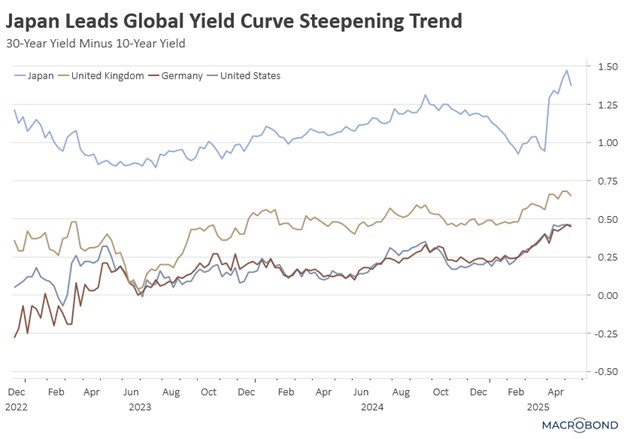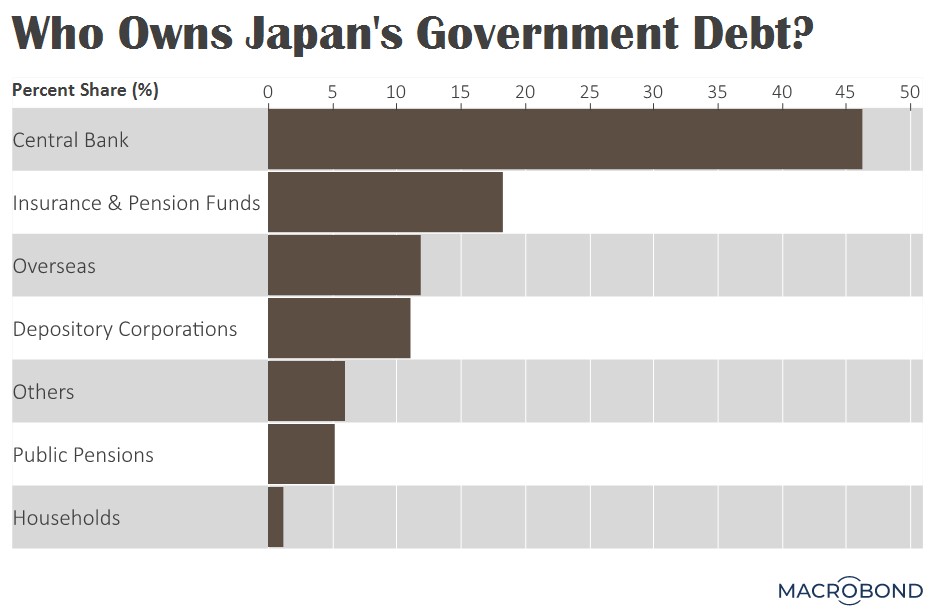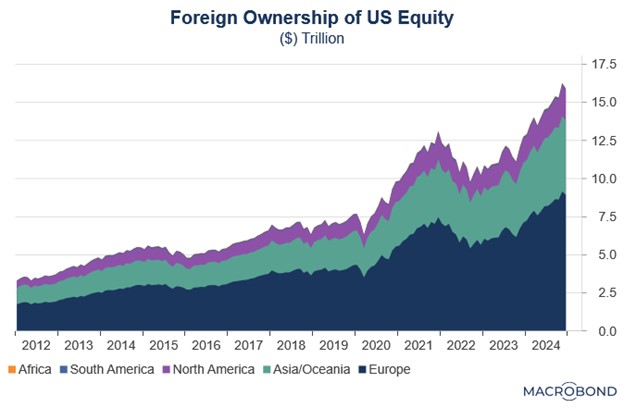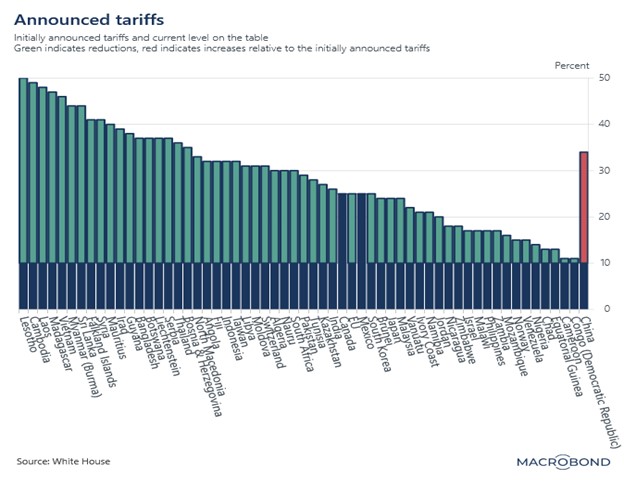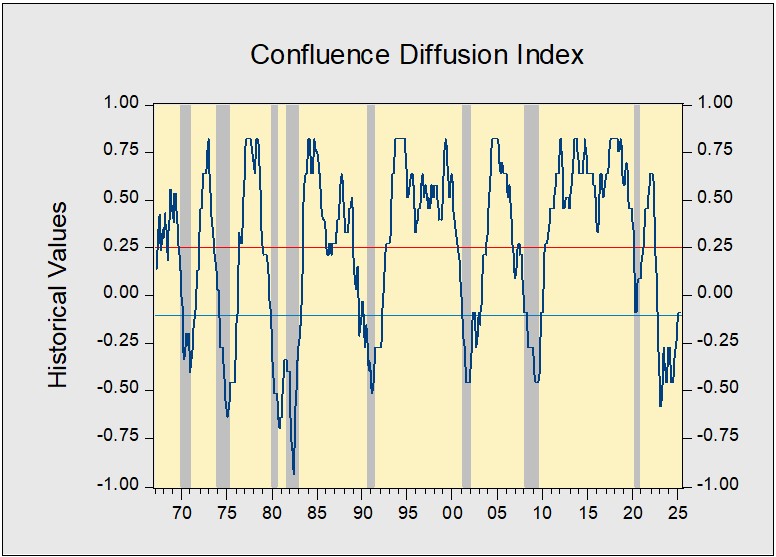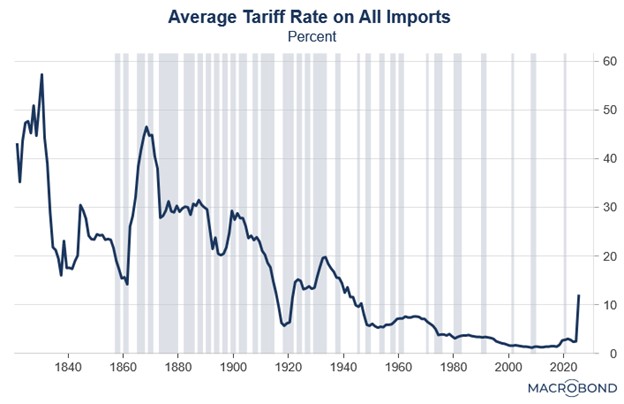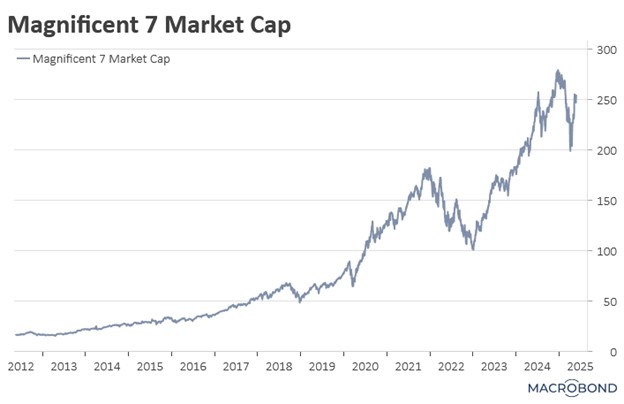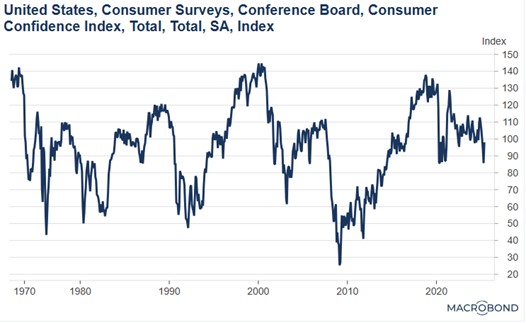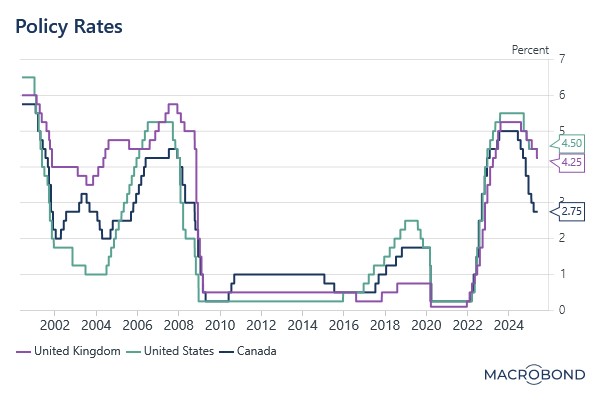Author: Amanda Ahne
Asset Allocation Bi-Weekly – The Japan Problem (June 2, 2025)
by Thomas Wash | PDF
Just one day after Prime Minister Shigeru Ishiba likened Japan’s debt situation to that of Greece, the country faced its weakest demand for 20-year bonds since 2012. The auction’s tail — the excess of its highest yield over its average yield — widened to 1.14, the largest since 1987. His timing could hardly have been worse, coming as investors were already scrutinizing government fiscal sustainability following Moody’s downgrade of the US credit rating.
The market reaction was swift and severe, with yields on 30-year and 40-year Japanese government bonds (JGBs) climbing to record highs. This dramatic shift caught many by surprise, considering that JGBs had been in strong demand just one month earlier. Global investors had been accumulating ultra-long JGBs at a record pace, with holdings reaching new highs for three straight months through April.
The bond market turmoil in Japan reflects mounting economic strains, with inflation at multi-decade highs and US tariffs threatening export growth. Rising rates have intensified concerns over servicing the world’s largest public debt burden at 200% of GDP, which is double the US’s ratio. These pressures are testing Japan’s fiscal stability as investors question long-term sustainability amid shrinking policy options.
The Bank of Japan’s (BOJ) quantitative tightening program has emerged as another key concern. With the BOJ currently holding approximately 46% of Japan’s outstanding government bonds, the central bank’s gradual reduction of bond purchases by roughly 400 billion yen ($2.77 billion) per quarter aims to cut monthly buying to 3 trillion yen ($20.7 billion) by March 2026. This planned withdrawal has created a significant supply-demand imbalance as traditional buyers such as pension funds and life insurers have failed to fill the void.
A key systemic risk lies in the potential global contagion from Japan’s bond market turmoil. Surging JGB yields may prompt large-scale capital repatriation by domestic investors, draining liquidity from overseas markets. This threatens US Treasury markets disproportionately as Japanese institutions — the largest foreign holders — could reduce their substantial holdings, potentially tightening financial conditions stateside.
If surging Japanese yields also spark a sustained appreciation of the yen, it could also spark a disorderly unwind of carry trades, with potential spillovers across global markets. The classic “short yen, long dollar” trade, which sparked volatility during last summer’s abrupt reversal, could face renewed pressure if the BOJ intervenes to support its bond market. Such a scenario might force leveraged investors to cover short positions, potentially triggering cascading margin calls and fire sales across equities, credit, and emerging markets.
In the current climate of bond market volatility, we believe precious metals, particularly gold, offer an effective hedge against uncertainty. Diversification into non-correlated assets remains the most prudent strategy to mitigate risks in global fixed income markets. Gold’s historical role as a safe-haven asset makes it especially compelling during periods of bond market stress. We also see high-quality equities as another potential defensive allocation, providing both capital preservation and growth potential amid turbulent conditions.
Don’t miss our accompanying podcasts, available on our website and most podcast platforms: Apple | Spotify
Daily Comment (May 30, 2025)
by Patrick Fearon-Hernandez, CFA, and Thomas Wash
[Posted: 9:30 AM ET] | PDF
Good morning! The White House is once again using Friday to remind markets about its trade concerns. Today’s Comment will discuss how a provision in the tax bill could discourage foreign investment in the US, explain why the administration is crafting a backup plan for tariffs, and report on other latest market-moving developments. As always, we’ll also include a roundup of key domestic and international economic data.
Taxing Foreigners: A little-known provision within the tax bill has caused a stir on Wall Street due to its potential to hurt the US’s safe-haven status.
- Section 899 of the recently passed House legislation authorizes the US government to implement reciprocal tax measures against investors and corporations from countries found to maintain discriminatory tax practices targeting American entities. The provision’s broad scope could significantly affect both: (1) US-domiciled firms with substantial foreign ownership, and (2) multinational corporations maintaining operations or investment ties in the US.
- The measure appears primarily targeted at the European Union, which US officials have accused of maintaining discriminatory policies against American companies. The White House has repeatedly urged the EU to reform its Value-Added Tax (VAT) system, arguing it creates unfair trade advantages for member states. This tension has escalated as several EU countries (most recently Germany) have moved forward with proposed digital taxes that would disproportionately affect US tech giants like Meta and Google.
- However, the provision contains significant ambiguity regarding its application to US Treasury securities. While the legislation clearly subjects foreign holders of equities and corporate bonds to potential levies, it fails to clarify whether purchases of government debt — traditionally exempt from such taxation — would also become taxable. The lack of clarity could create an incentive for foreign investors to purchase even more US government bonds.
- This law essentially functions as a form of capital control. Its underlying rationale likely stems from a desire to pressure foreign elites into advocating for US interests, particularly regarding regulatory restrictions. By targeting influential individuals who comply with laws that disadvantage American companies, the US is effectively leveraging financial coercion. The potential impact is twofold: It could drive increased investment into US Treasurys, or it trigger capital outflows from equities.
Trade Developments: The Trump administration has received a reprieve from the courts on its tariffs but is already searching for a backup as it looks to regain leverage in trade talks.
- A US federal appeals court has lifted the hold on global tariffs, clearing the way for the White House to escalate the issue to the Supreme Court. This decision is expected to reinstate the president’s import tariffs, reinforcing his push to reshape US trade policy. However, the long-term viability of these levies remains uncertain. The reprieve came after two separate rulings deemed the administration’s approach as unlawful.
- As noted in yesterday’s comment, the president has options should the tariffs be deemed unconstitutional. The administration is exploring the use of the Trade Act of 1974, which permits temporary tariffs of up to 15% for 150 days to rectify trade imbalances. Additionally, the White House is preparing to leverage Section 301, which grants the US authority to investigate and retaliate against unfair trade practices. There have also been discussions about invoking the Smoot-Hawley Tariff Act of 1930 as a potential fallback.
- That said, the ruling has significantly impacted perceptions of the US’s capacity to negotiate effectively with its trading partners. While the US and the European Union have committed to ongoing dialogue in an effort to resolve their trade differences, discussions between the US and China have, by contrast, reportedly reached an impasse. Following the court’s decision, President Trump sharply criticized China for failing to meet its trade agreement commitments.
- The ongoing tariff dispute is likely to fuel further market uncertainty regarding future trade policy. Investors now face a dual challenge where they must not only assess whether new tariffs will be implemented, but also whether existing ones will remain in place. This persistent ambiguity will disproportionately pressure firms with significant trade exposure. Given these conditions, we maintain that the most compelling opportunities lie in companies with resilient earnings power and fortified supply chains.
Monetary Policy Dilemma: President Trump and Fed Chair Powell met this week for the first time since November 2019 to discuss the economy.
- During the meeting, President Trump pressed Chair Powell to cut interest rates at the upcoming FOMC meeting, arguing that the US should align with other central banks’ policies. However, the Fed chair avoided signaling any commitment to the president’s demands, instead emphasizing that the Fed’s decisions would remain data-dependent and based on economic developments.
- The challenge confronting the president and Federal Reserve officials is the impact of US tariffs on both the domestic and global economies. Tariffs, or import taxes, serve two main purposes: revenue generation and import restriction. The latter is arguably the more complex aspect. While US tariffs have the potential to inflate domestic prices by increasing the cost of imported goods or limiting supply, they can simultaneously lead to excess foreign capacity, thereby driving down prices abroad.
- This dynamic is likely to place the Federal Reserve at a disadvantage relative to its international peers. Assuming all other factors are constant, foreign central banks possess greater latitude to implement rate cuts because the decline in exports due to US tariffs has created a surplus of domestic supply, prompting them to stimulate demand. Conversely, the reduction in foreign imports means the Fed may need to maintain higher rates to prevent increased demand from exacerbating domestic supply chain constraints.
- The key uncertainty lies in how US businesses will adapt to tariffs. Some firms may attempt to pass through higher costs, which would reinforce the Fed’s current policy stance. Others may resort to workforce reductions to mitigate the financial impact. This divergence in responses makes unemployment the potential swing factor in the tariff policy calculus.
- We acknowledge the possibility of both higher inflation and higher unemployment, but we’re not convinced they’ll trend upward simultaneously. This phenomenon, known as stagflation, typically occurs during sharp increases in energy prices, which are currently trending downward. Given the hiring trends and the limited purchasing power of households since the pandemic, we believe a cooling labor market is the most likely scenario. Consequently, we think the Fed could still cut rates this year.
Demand Optimism: Despite recession concerns, there are still signs that households may not be changing their spending habits by much.
- Recent driving data indicates that Americans hit the road in greater numbers this holiday weekend. According to GasBuddy, gasoline consumption has increased by 2% compared to the previous year. This uptick suggests households may be shifting spending away from goods and toward services — a potential strategy to mitigate the impact of rising tariffs.
- The shift toward service-oriented spending is expected to bolster the economy amid ongoing uncertainty. This trend will likely persist, provided that businesses keep prices in check. As a result, an immediate recession seems unlikely.
Business Cycle Report (May 29, 2025)
by Thomas Wash | PDF
The business cycle has a major impact on financial markets; recessions usually accompany bear markets in equities. The intention of this report is to keep our readers apprised of the potential for recession, updated on a monthly basis. Although it isn’t the final word on our views about recession, it is part of our process in signaling the potential for a downturn.
In April, the US economy continued to grow broadly with no immediate signs of contraction. The composite economic index remained just above the recession threshold and showed minimal change from the previous month’s reading. While employment indicators continued to demonstrate resilience, other sectors presented a more nuanced picture. Financial markets and real economic data sent mixed signals, suggesting an economy at a crossroads between sustained growth and potential softening. This dichotomy between strong labor markets and weaker production indicators bears close monitoring in coming months.
Labor Market
The labor market showed gradual easing from its recent peaks while remaining tight by historical standards. Initial jobless claims and employer payrolls pointed to ongoing strength in the demand for labor. In contrast, the two-year change in the unemployment rate signaled potential weakness. This divergence suggests that while hiring may be cooling from its torrid post-pandemic pace, underlying demand for workers remains robust. The continued labor market tightness provides an important buffer against broader economic weakness, supporting consumer spending and overall growth.
Financial Markets
Financial markets delivered conflicting messages about economic prospects. Equity markets rallied on optimism that potential trade restrictions might be less severe than initially anticipated, reflecting confidence in corporate earnings. However, bond markets told a more cautious story, with Treasury yields ending the month slightly lower as investors priced in greater economic uncertainty. This disconnect between equity and fixed income markets typically signals investor debate about future growth trajectories, with bond markets often proving more prescient about economic turning points.
Goods Production and Sentiment
The goods-producing sector emerged as the economy’s weakest link in April, with three of four key diffusion indicators in contraction territory. Consumer sentiment remained depressed, potentially foreshadowing softer spending ahead. Business investment showed particular weakness, evidenced by sluggish housing starts and declining capital expenditures. These trends suggest corporate leaders are growing more cautious about future demand. However, supplier delivery times — often an early indicator of economic activity — remained elevated, pointing to persistent underlying demand that could support continued expansion.
Outlook and Risks
While recession risks persist, current data suggests the economy will likely avoid contraction in the near term. The primary uncertainties center on potential trade policy impacts and whether labor market strength can offset softness elsewhere. There are signs of growing margin pressures that could eventually affect hiring and investment decisions. Our baseline projection anticipates continued modest growth through the third quarter, though the economy appears increasingly vulnerable to external shocks. Investors should remain vigilant for signs of broader economic deterioration, while increasing risk exposure may be warranted as the economic outlook becomes clearer.
The Confluence Diffusion Index for May, which encompasses data for April, remained slightly above the recovery indicator. However, the report showed that five out of 11 benchmarks are in contraction territory. Using April data, the diffusion index was unchanged at -0.0909 and above the recovery signal of -0.1000.
- Equity prices bounced back following trade progress.
- Manufacturing data offered mixed signals.
- Hiring picked up in a sign that labor conditions remain tight.
The chart above shows the Confluence Diffusion Index. It uses a three-month moving average of 11 leading indicators to track the state of the business cycle. The red line signals when the business cycle is headed toward a contraction, while the blue line signals when the business cycle is in recovery. The diffusion index currently provides about six months of lead time for a contraction and five months of lead time for recovery. Continue reading for an in-depth understanding of how the indicators are performing. At the end of the report, the Glossary of Charts describes each chart and its measures. In addition, a chart title listed in red indicates that the index is signaling recession.
Daily Comment (May 29, 2025)
by Patrick Fearon-Hernandez, CFA, and Thomas Wash
[Posted: 9:30 AM ET] | PDF
Good morning! Markets are actively digesting this morning’s landmark court ruling on tariffs. Today’s Comment examines how the Trump administration might respond to this latest trade policy setback, discusses the market implications of Nvidia’s stronger-than-expected earnings, and reviews other notable news moving global markets. As always, we’ll wrap up with a comprehensive overview of today’s most important domestic and international economic data releases.
No TACO For Trump: A court ruling has delivered a major setback to the US president’s trade agenda, yet his supporters are pressuring him not to retreat.
- The US Court of International Trade ruled that the president lacked the authority to impose tariffs under the emergency economic powers legislation he cited. This decision will invalidate certain reciprocal tariffs enacted on April 2, while leaving in place sector-specific tariffs on automobiles and steel. Although the White House has stated it will appeal the ruling, the verdict raises doubts about the legality of his broader tariff strategy.
- The ruling is expected to halt 6.7% of levies announced this year. However, the president appears to have alternative options to circumvent the court’s decision. According to Goldman Sachs, the administration could implement Section 122 tariffs for up to 150 days as a replacement for reciprocal tariffs, while simultaneously applying Section 301 and 232 tariffs on a country-specific basis.
- That said, the ruling could place the White House in a difficult position as it seeks to negotiate trade agreements with other nations. In recent weeks, tariff threats have successfully pressured several countries into trade discussions. Notably, the European Union, which initially pushed for complete tariff elimination, has now softened its stance, seeking reduced tariffs in exchange for concessions in other areas.
- Additionally, Trump faces mounting pressure to maintain his stance, particularly given concerns over market stability. The White House was compelled on Wednesday to push back against claims that “Trump Always Chickens Out,” a narrative that belittles the so-called “Trump put,” the perception that the president will consistently safeguard equity markets.
- While the court’s decision represents a setback for the administration, it is unlikely to be the final word on the matter as the White House prepares its appeal. Investors should therefore view the tariff reversal with caution. Our primary focus will be on the president’s response, as he may use this ruling to reinforce his protectionist stance rather than retreat. Given the potential for increased volatility, we maintain that conservative investors should adopt a wait-and-see approach in the current environment.
AI Rally Continues: Big tech stocks rallied on Wednesday after the world’s leading chipmaker reported stronger-than-expected earnings, reinforcing confidence in the sector’s growth.
- Nvidia surpassed analyst expectations with a strong quarterly revenue of $44.1 billion, marking 70% year-over-year growth despite significant headwinds from US export controls. The results comfortably exceeded Wall Street’s $43.3 billion consensus estimate, demonstrating remarkable resilience in the face of geopolitical challenges. For the current quarter, the chipmaker issued bullish guidance of $45 billion in revenue while disclosing an anticipated $8 billion hit from ongoing China sales restrictions.
- The earnings beat is poised to reinvigorate confidence in the AI rally, which has been largely driven by the seven biggest tech giants propelling the S&P 500. Recent concerns over US trade restrictions, particularly on exports, had raised fears that tech earnings could suffer and potentially dampen investment enthusiasm. Yet, Nvidia’s robust results suggest that major players remain committed to AI investments and undeterred by global economic uncertainty.
- Despite reporting robust earnings, Nvidia raised alarms over potential new US export controls on China. In a direct appeal to President Trump, CEO Jensen Huang warned that existing restrictions could completely shut Nvidia out of the Chinese market — a devastating outcome for the chipmaker’s revenue. His plea follows reports that the Trump administration is considering expanded bans, including cutting off sales of critical chip design software to China.
- The strong earnings report indicates that high-quality risk assets will remain appealing to investors navigating ongoing economic uncertainty. Companies with robust earnings growth potential and minimal foreign supply chain exposure are particularly well-positioned in this environment. Additionally, firms aligned with government strategic priorities, such as AI, present compelling opportunities for investment.
FOMC Meeting Minutes: According to its meeting minutes, the Federal Reserve opted to hold interest rates steady as it continues to navigate the economic fallout from the trade war.
- During the FOMC meeting held on May 6-7, Fed officials acknowledged they might face difficult trade-offs when deciding which aspect of their dual mandate — price stability or full employment — to prioritize. Their unease stemmed from navigating turbulent financial market conditions, including heightened volatility in equities and bonds. Adding to their concerns was the dollar’s significant depreciation, which further complicated the economic outlook.
- On a positive note, Fed officials expressed cautious optimism that households could weather the impact of tariffs. While acknowledging rising delinquencies on auto and credit card loans, they noted that household balance sheets remain fundamentally strong. Additionally, some policymakers suggested that lower energy prices might help offset trade-related pressures. There was even hope that consumer spending could gradually shift from goods to services, further easing economic strains.
- On the other hand, Fed officials also highlighted several growing vulnerabilities in the economy. One key area of concern is rising leverage within the financial sector, with banks potentially exposed to interest rate risks and hedge funds carrying significant debt. Additionally, they expressed concerns about the weakening status of US assets as a safe haven, raising questions about the economy’s long-term stability.
- Regarding policy, there appears to be broad agreement that significant uncertainty will persist until the president finalizes tariff rates. The staff economic outlook projects inflation will prove transitory, with a temporary increase this year and next before returning to the 2% target by 2027. Additionally, staff estimates suggest the unemployment rate may rise above its natural level by year-end.
- The meeting minutes indicate that the central bank may refrain from cutting rates at its next meeting and could delay rate cuts this year if inflationary pressures persist. This stance would likely push bond yields higher while dampening bond prices. Moreover, elevated interest rates may weigh on equity markets, particularly riskier assets.
DOGE Future: Tesla CEO Elon Musk has officially stepped down from overseeing the cost-cutting initiative, though the future of his efforts remains uncertain.
- The world’s richest man has stepped down from his role to dedicate more time to his business ventures. His position as a “special government employee” was capped at 130 days, meaning it was always expected to conclude by the end of the month. While leading the Department of Government Efficiency, he was tasked with identifying cost-saving measures to reduce government spending. While he successfully uncovered some inefficiencies, the effort fell far short of his ambitious $1 trillion savings target.
- However, he has submitted a list of $9.4 billion worth of proposed spending cuts to Congress, which must now decide whether to enact them into law. President Trump has urged lawmakers to prioritize these cuts, which include reduced funding for USAID and the Corporation for Public Broadcasting (CPB), the entity overseeing PBS and NPR.
- While Musk may be departing his government role, sustained efforts will still be needed to address the nation’s fiscal challenges. We believe the growing supply-demand imbalance in bond markets is exacerbating pressure on yields, particularly for long-term bonds. Consequently, we expect the DOGE initiative to persist in promoting fiscal discipline — a critical factor in restoring confidence among bond market participants.
Daily Comment (May 28, 2025)
by Patrick Fearon-Hernandez, CFA, and Thomas Wash
[Posted: 9:30 AM ET] | PDF
Good morning! The market is currently paying close attention to the bond market and Nvidia’s earnings. Today’s Comment will talk about the unexpected jump in consumer sentiment and explore the factors behind this shift in optimism. We will also examine why King Charles’ speech added to US-Canada tensions and provide updates on other key financial reports. Finally, we’ll close with a summary of today’s major international and domestic data releases.
Confidence Bounce: Consumer sentiment rebounded in May, reflecting household relief amid progress in trade negotiations.
- The Conference Board’s Consumer Confidence Index significantly outperformed expectations in May, rising to 98.0 from a revised 85.7 in April. This notable increase was driven primarily by a dramatic improvement in consumer expectations, which surged 17.4 points from a historic low of 55.4 to 72.8. The Present Situation Index also showed strength, climbing from 131.1 to 135.9, suggesting households are growing less concerned about immediate recession risks.
- The recent improvement in consumer sentiment was largely driven by reduced concerns about potential tariffs fueling inflation. Notably, inflation expectations declined from 7.0% to 6.5%, reflecting growing confidence in price stability despite tariff concerns. The survey also revealed increased consumer willingness to make major purchases, with more respondents indicating plans to buy automobiles and take vacations within the next twelve months.
- While inflation expectations have moderated, lingering concerns about economic stability persist. The labor market indicators present a mixed picture. The share of respondents reporting jobs as “plentiful” edged up modestly from 31.2% to 31.8%, while those describing jobs as “hard to get” rose more significantly from 17.5% to 18.6%. This divergence suggests continued consumer skepticism about labor market strength, despite some positive signals.
- The latest Conference Board survey indicates consumers are increasingly attuned to economic shifts. While household spending is expected to remain strong if the economy continues its positive trend, a scenario where tariffs don’t spark inflation and the labor market softens could push the Federal Reserve to ease monetary policy.
The 51st State? The king’s recent speech in front of the Canadian Parliament has brought renewed attention to the US threat of acquiring Canada.
- In his address, King Charles III emphasized that the nation faces grave threats to its democratic institutions, rule of law, and right to self-determination. Although he did not explicitly mention President Trump by name, the timing of these remarks is significant, as they coincide with the US president’s persistent efforts to bring the country under greater American influence. This speech will likely intensify ongoing debates about Canada’s relationship with its southern neighbor and the future of bilateral sovereignty issues.
- Discussions about reshaping the US-Canada bilateral relationship come as leaders from both nations seek to redefine their strategic partnership. The two countries explored collaborating on a joint missile defense system, dubbed the “Golden Iron Dome,” which would be capable of detecting, tracking, and intercepting attacks. While President Trump has threatened to charge Canada $61 billion for access to the system, its success would depend heavily on Canada’s radar coverage and Arctic airspace access.
- Rising tensions with its southern neighbor could further pressure Canadian equities. The country is already grappling with a weakening economic outlook, including slowing job growth, subdued business optimism, and a GDP contraction in Q1. A protracted dispute with its largest trading partner would only compound these challenges, adding fresh uncertainty to an already strained market environment.
- Despite escalating tensions between Canada and its largest trading partner, the country’s benchmark S&P/TSX Composite Index continues to trade near all-time highs — even outperforming the S&P 500 year-to-date. This resilience stems from the index’s heavy weighting in Energy and Financials, sectors relatively insulated from tariff risks. While economic pressures from trade disputes remain a concern, Canada’s market strength serves as a reminder that even in politically uncertain environments, pockets of opportunity can still emerge.
Japan’s Auction Blunder: Global bond yields rose following weak demand for longer-duration security issuance in Japan.
- Japan’s 40-year government bond auction drew its weakest demand since last July, despite offering higher yields. The bid-to-cover ratio — a key gauge of investor appetite — came in at 2.21, marking the second-lowest level since the pandemic. This tepid response underscores growing market reluctance to take on longer-duration risk, particularly in heavily indebted economies.
- The tepid demand for ultra-long bonds is increasing pressure on Japan’s Ministry of Finance to rebalance its issuance strategy toward shorter-dated securities. This shift would help contain long-term borrowing costs while meeting market demand, a move already showing some effect after Tuesday’s report about potential changes to the issuance mix helped ease 10-year JGB yields.
- The weak auction also presents new complications for the Bank of Japan’s normalization path. With investors showing limited appetite for duration risk, the central bank may need to adjust its balance sheet runoff plans to prevent excessive yield volatility. This development highlights the delicate policy coordination required between Japan’s fiscal and monetary authorities as they navigate an environment of rising global yields.
- The key trend we’re monitoring is the shift toward shorter-duration bond issuance among indebted developed countries. While this move helps alleviate yield pressures on longer-duration securities, it also increases the government’s exposure to rollover risk as bonds mature. This could pose challenges if unexpected shocks drive short-term rates higher. Although we do not anticipate this scenario materializing in the near term, we will closely track this dynamic.
Big Tech’s Litmus Test: The last Magnificent 7 company will report earnings this afternoon, in what could be the next major catalyst for equity markets.
- Nvidia’s upcoming quarterly earnings report represents far more than a routine corporate update — it will serve as the most consequential barometer of AI adoption and tech sector health. As the undisputed leader in AI accelerators, Nvidia has delivered eight consecutive quarters of earnings beats, transforming each report into a market-moving event that sets the tone for the entire technology ecosystem.
- The chipmaker’s unique position at the center of the AI infrastructure boom makes its financial performance particularly revealing. With every major cloud provider and tech giant racing to expand AI capabilities, Nvidia’s results will provide critical insight into whether corporate investment cycles remain intact despite macroeconomic pressures. Strong revenue growth and guidance would confirm sustained demand for AI infrastructure, while any weakness could signal broader enterprise spending pullbacks.
- Market implications extend well beyond the semiconductor sector. A bullish report could reignite the AI trade and potentially propel the S&P 500 above key psychological resistance at 6,000, as it would validate current growth expectations. Conversely, disappointing results might trigger a sector-wide repricing, particularly for high-multiple tech stocks that have benefited from the AI narrative.
Bi-Weekly Geopolitical Report – Why Greenland Matters (May 27, 2025)
by Daniel Ortwerth, CFA | PDF
Shortly after he became president again in January, Donald Trump surprised the world with statements about buying or annexing Greenland, by force if necessary. In early May, he reiterated this position, saying Greenland was needed for national security. Trump had initially proposed acquiring Greenland in his first term, but even that was not the first time the United States expressed such an interest. In 1946, at the beginning of the Cold War, President Truman secretly offered to buy Greenland from its owner, Denmark. On each occasion, Denmark has rejected the idea, but the repeated US overtures reveal that Greenland is important for reasons tied to the core interests of a global superpower.
This report explores the main reasons why Greenland is getting so much attention. It begins with a review of the military value of Greenland, continues with considerations of its evolving potential role in global trade, and further delves into the island’s prospects as a natural-resources play. Ultimately, we show how Greenland serves as a lens through which to view strategic developments in the broader Arctic region. As always, we conclude with investment implications.
Don’t miss our accompanying podcasts, available on our website and most podcast platforms: Apple | Spotify
Bi-Weekly Geopolitical Podcast – #67 “Why Greenland Matters” (Posted 5/27/25)
Daily Comment (May 27, 2025)
by Patrick Fearon-Hernandez, CFA, and Thomas Wash
[Posted: 9:30 AM ET] | PDF
Our Comment today opens with the positive news that President Trump has postponed his threatened additional tariff hikes on the European Union, and the EU has agreed to accelerate the negotiations for a US-EU trade deal. We next review several other international and US developments with the potential to affect the financial markets today, including a welcome pause in the sell-off of Japanese government bonds and a potentially important change in the asset allocation strategy of major US university endowments.
United States-European Union: President Trump on Sunday finally had an extended phone call with European Commission President von der Leyen, which itself was newsworthy after Trump and his administration had kept the European Union at arm’s length and sharply criticized it for months. Perhaps more important, Trump also agreed to push out his deadline to reach a US-EU trade deal and avoid massive new tariffs on the EU. The deadline is now July 9. The events point to a thaw in US-EU relations, giving a boost to US and foreign stocks today.
United States-Russia: After Russia on Sunday launched a huge missile and drone attack against about 30 Ukrainian cities, killing dozens, President Trump blasted President Putin on social media, saying, “I’ve always had a very good relationship with Vladimir Putin of Russia, but something has happened to him . . . . He has gone absolutely CRAZY! He is needlessly killing a lot of people, and I’m not just talking about soldiers.”
- The rare criticism of Putin could be a sign that Trump is finally recognizing the Russian leader’s uncompromising aggression and menace he poses to European countries. Reports today indicate Trump is even considering new US sanctions against Russia.
- All the same, even if that’s the case, it’s not entirely clear how Trump’s foreign policy would really change. For example, he could still wash his hands of the Russia-Ukraine war and further cut US support for Kyiv, putting more of the burden on Europe. Alternatively, he could conceivably swing toward more support for Kyiv, potentially helping improve the security situation in Europe.
Japan: After weeks of falling values and rising yields, Japanese government bonds with longer maturities are rallying strongly today, pushing yields lower. The shift came after the finance ministry took the rare step of canvassing primary dealers and other market participants for their views on issuance. The move suggests the ministry may be preparing to scale back supply, which could help put an end to the market’s recent volatility. However, issues such as the US-Japan trade war and reduced buying by the Bank of Japan could still be a concern.
Chinese Fiscal Policy: The Chinese government has green-lighted a new 767-kilometer canal to link Jiangxi province, a center for electric-vehicle manufacturing and rare earths production, with the coastal powerhouse of Zhejiang. The canal is part of a $44-billion mega project to provide low-cost freight transport via canal between Guangdong, Jiangxi, and Zhejiang. While it’s tempting to think China has already made all the high-return infrastructure investments it needs, the canal project is considered an important step in cutting China’s high freight costs.
Chinese Electric Vehicle Industry: EV giant BYD on Monday announced a series of deep, new price cuts, one of which would drop the domestic price of its cheapest model to just $7,770. The move is expected to worsen the on-going price war in China’s EV market, so Chinese EV stocks dropped sharply yesterday. The move could also incentivize Chinese manufacturers to boost their export efforts, pressuring foreign EV makers as well.
India: Monsoon rains hit the southernmost state of Kerela on Saturday, arriving eight days earlier than normal and marking the earliest monsoon in 16 years. If sustained, the early rains are expected to boost India’s agricultural output, help keep a lid on food prices, increase economic output, and potentially bolster political support for Prime Minister Modi. Also, any increase in Indian crop production could have some negative impact on the value of global agricultural commodities.
Eurozone: The hawkish head of Austria’s central bank, Robert Holzmann, said in an interview that he sees “no reason” for the European Central Bank to further cut interest rates in either June or July. Since Holzmann sits on the ECB’s policymaking committee, the statement suggests a high level of disagreement among ECB policymakers about how to best shield the eurozone economy from the US-EU trade war.
United Kingdom: In an interview, the chief of the government’s Debt Management Office, Jessica Pulay, said her agency is starting to reduce its heavy issuance of longer-dated obligations because of waning demand among institutional investors. Shifting issuance more toward shorter-duration debt would likely help to contain the UK’s rising interest costs, but it would also subject the government to more financial volatility and give investors more leverage to demand fiscal discipline.
- In any case, Pulay’s statement about waning demand for long-dated government debt appears to reflect a growing trend worldwide. For example, it’s consistent with the “buyer’s strike” hitting Japanese debt, as mentioned earlier in this Comment. It’s also consistent with the volatility in the US bond market after Moody’s recent cut to the US debt rating.
- More broadly, global investors’ growing skittishness about long government debt also probably reflects the increased uncertainty and transition risks as the world moves beyond globalization to the new era of greater geopolitical tension, risk, and economic change.
US Financial Markets: Major university endowments are reportedly mulling big changes in their investment strategies in response to the Republican tax and spending bill passed by the House last week. If passed into law, the bill would sharply boost the tax on endowments’ investment income. Endowment managers are therefore considering shifting billions of dollars of investments away from assets that generate short-term gains. Instead, they may allocate even more to private equity and debt, which don’t realize gains for years into the future.
US Pharmaceutical Industry: The Wall Street Journal today carries an article showing how the popular GLP-1 drugs for obesity and diabetes are increasingly being found effective in treating other conditions, including heart disease, kidney disease, liver disease, sleep apnea, arthritis, and even Alzheimer’s. With researchers continuing to find new uses for them, GLP-1 drugs could become an even more important part of the pharmaceutical industry’s health going forward. However, much will depend on the Trump administration’s regulation of the drugs.



